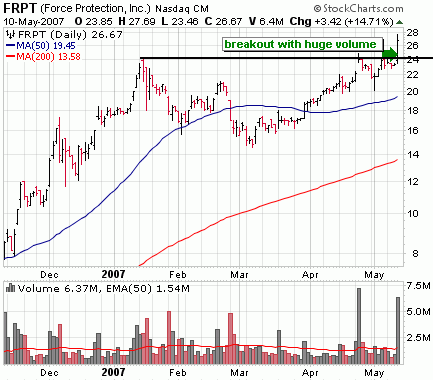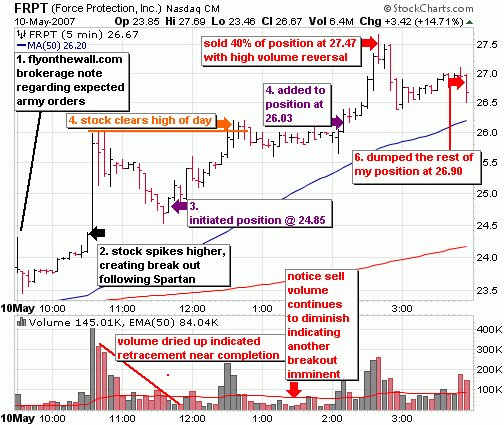The following post is provided exclusively to readers of SelfInvestors, courtesy of TheCorrectCall.com. Some great ideas for safer investing strategies in a bear stock market. Previously, they recommended a gold trade which I agree with 100%.. I recently added a gold play in the Self Investors Model Portfolio which did quite well yesterday.
:::::::::::::::::::::::::::::::::::::::::::::::::::::::::::::::::::::::::::::::::::::::::::::::::::::::::::::::::::::::::::
"RBS issues global stock and credit crash alert"
"Morgan Stanley warns of ‘catastrophic event’ as ECB fights Federal Reserve"
"Everything seemingly is spinning out of control"
These are some of the alarming headlines that many of our readers and The Correct Call have read recently. Crashes, Catastrophes, Spinning Out of Control. are these Chicken Little warnings? or are dark clouds gathering and about to unleash a withering financial storm?
The truth is we don’t pretend to know one way or the other. It is vital to remain objective and take what the market gives you. The Correct Call takes a top-down approach and sees what the market is saying and invests accordingly. We are not afraid of negativity or overwhelmed by optimism. As a result, we believe there are always great opportunities out there no matter the environment.
That being said, many of our readers have asked us "what can I do to protect my portfolio in this market?" So we did our research looking for investments that have little, no, or negative correlation with US stocks; meaning, investments that don’t necessarily move in tandem with stocks. They have their own free will, so to speak.
We have identified 7 things you can do to protect your portfolio RIGHT NOW!
- CASH is KING:
- Don’t be afraid to move some money to the sidelines. Selling losers makes a lot of sense. It can take years for many of these companies to recover. We are still waiting for many of the tech darlings of the late 90’s and early 2000’s "to get back to what we paid for them." How long before Qualcomm gets back to $88, let alone $1000.
Some of the things you should be looking at to determine which of your stocks are cash candidates include:- Earnings Misses Bad News Management Shake-Ups Deteriorating Fundamentals Relative to its Peers Desperate for an Infusion of Cash
Once you have decided which stocks make sense to sell, you might consider matching your loses with some of your gains. Don’t be greedy, eventually today’s winners will give way and be replaced by the next hot thing.
When the markets – be it Real Estate or Stocks – hit rock bottom, you will need cash on hand to take advantage of these bargains. It is in these discarded investment misfits that triple digit returns will be found. - BUY GOLD:
- Investors worried about mounting losses can possibly stem the tide by adding Gold to their portfolio. According to a study titled "Is Gold a Hedge or a Safe Haven? An Analysis of Stocks, Bonds and Gold" by Dirk G. Baur and Brian M. Lucey, gold is an "ideal venue to park money during periods of uncertainty."
Their analysis found that in the US, Gold and stock returns are negatively correlated and that Gold acts as a hedge at all times. That means when stocks go down, Gold usually goes up.
Conservative investors should buy iShares COMEX Gold Trust (IAU), streetTRACKS Gold Trust (GLD) or iShares Silver Trust (SLV). More aggressive investors might consider owning individual stocks or DB Gold Double Long ETN (DGP). DGP’s objective is to give its owners twice the return of Gold’s price changes. With DGP, if Gold moves up 5%, investors can expect see a return of 10%. - INVEST IN TIPS:
- Worried about inflation? You should be, but inflation is negatively correlated to stock. When inflation is on the rise, stocks tend to fall. Here is how you can profit.
Treasury Inflation-Protected Securities, or TIPS, provide protection against inflation. The principal of a TIPS increases with inflation and decreases with deflation, as measured by the Consumer Price Index. When a TIPS matures, you are paid the adjusted principal or original principal, whichever is greater.
TIPS pay interest twice a year, at a fixed rate. The rate is applied to the adjusted principal; so, like the principal, interest payments rise with inflation and fall with deflation.
One of easiest way to invest in TIPS is through iShares Lehman TIPS Bond Fund (TIP). - NON-DOLLAR BONDS:
- Non-dollar denominated bond funds have little correlation with US stock prices. Again, the importance of this is that the performance of foreign currency based bond portfolios and US stocks are unlinked and move up and down for different reasons. International bond exposure should help limit your portfolio’s volatility and preserve purchasing power when the dollar is falling.
One such no-load fund is the T.Rowe Price International Bond Fund (RPIBX) . The fund’s objective is to provide high current income and capital appreciation by investing primarily in high-quality, non-dollar-denominated bonds outside the U.S. Right now 91.2% of the fund is composed of foreign bonds with more than 80% rated "A" or better. - MANAGED FUTURES:
- Managed Futures accounts are like mutual funds as they pool investors’ money into one portfolio. The portfolio managers have the discretion to invest long or short in futures contracts within equity indexes like the S&P, NASDAQ, & Dow, commodities like soy, corn, coffee, sugar., foreign currencies, and US government bond futures. Most of these accounts rely on proprietary quantitative models, more commonly known as "black box" strategies.
One of the purported advantages of managed futures is that these accounts have historically exhibited low or even negative correlation with US stocks and are capable of producing gains under any market conditions.
Some of the drawbacks of these portfolios have been:- Large initial investment required. Limited liquidity as typically there is a minimum holding period before having the ability to withdraw funds. Very little in the way of information.
Fortunately, Rydex Funds have solved many of these problems. Starting at just $25,000, investors can now own Rydex Managed Futures Strategy in 3 classes: A Shares (RYMTX), C Shares (RYMZX) and H Shares (RYMFX.)
- COVERED CALLS:
- Covered Calls are an options strategy whereby investors who own stock sell call options against that stock. For example, Joe Investor owns 1000 shares of IBM, he writes or sells another investor the right to acquire his shares at a set price, called the strike price, usually on, but sometimes before a specific date, otherwise known as the expiration date.
For our example, the IBM July 125 Calls are trading at $2.90 per contract. Each contract represents or controls 100 shares of IBM, 10 contracts equals 1000 shares. As a covered call writer, you sell the calls and receive $2,900 (100 * $2.90 * 10 contracts). The $2,900 is deposited into your account.
Two things can happen when the options expire in July:- We will start with the worst case scenario. IBM stock goes higher than or equal to $125. In this case, the investor who owns the option will buy it from Joe at $125, but he gets to keep the $2,900. If Joe wants to keep the stock, he will have to buy the options back, known as covering a position. In most cases investors will have to pay more than the premium received when selling the options.
In the 2nd scenario, IBM stays under $125 per share. In this situation Joe keeps his IBM shares and, if he likes, can sell more options and collect more money. - SHORT ETFs:
- The objective of a short ETF is to go up in value when the underlying index goes down. For example, if the NASDAQ 100 index were to drop 10%, the short NASDAQ 100 ETF would rise 10% in value. Some of these funds offer leverage and produce twice the return of the index.
ProShares offers a robust offering of both types of short ETFs. For a complete list visit http://www.proshares.com/funds?products=98616&fundType=
. Keep in mind, when the markets go up, these ETFs WILL LOSE VALUE.
The Correct Call suggests that conservative investors commit up to 10% of their entire portfolio to a mix of these strategies. More aggressive types can allocate closer to 30% of their equity holdings into these hedges.
 2DIME’S INVESTOR NOTES
2DIME’S INVESTOR NOTES
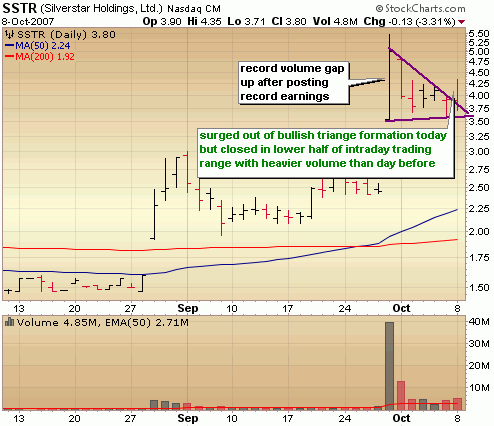
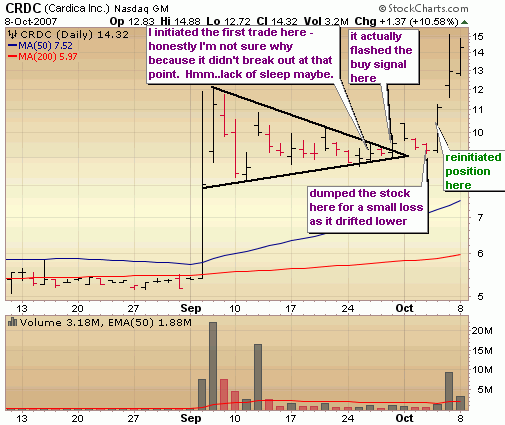
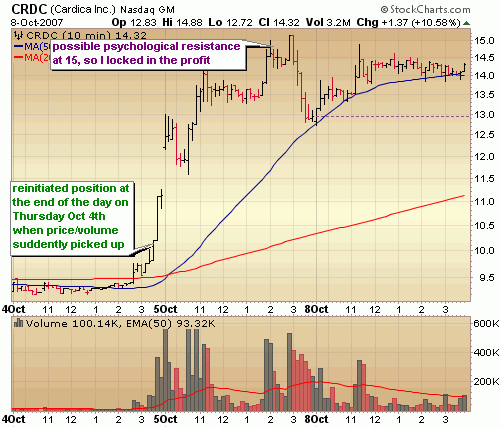
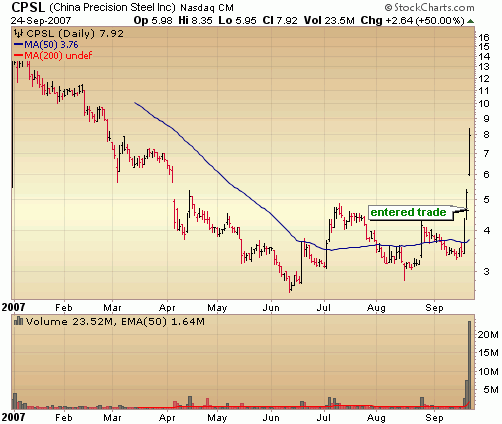
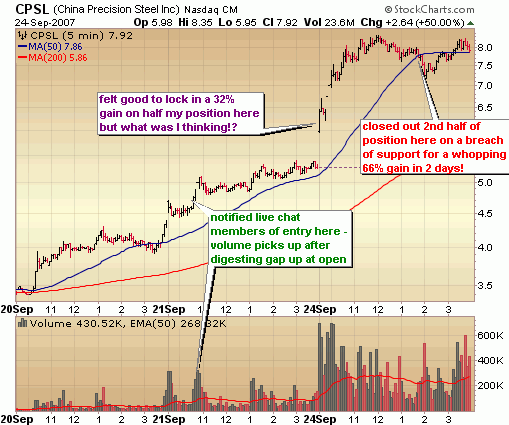
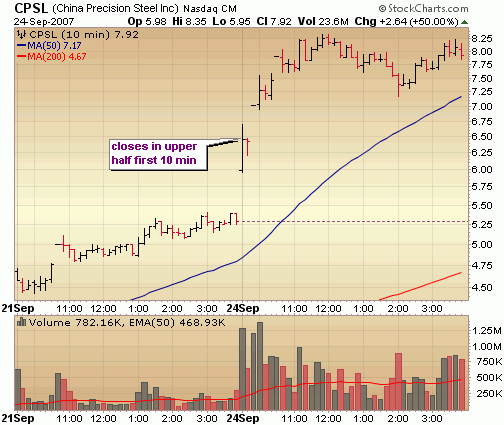

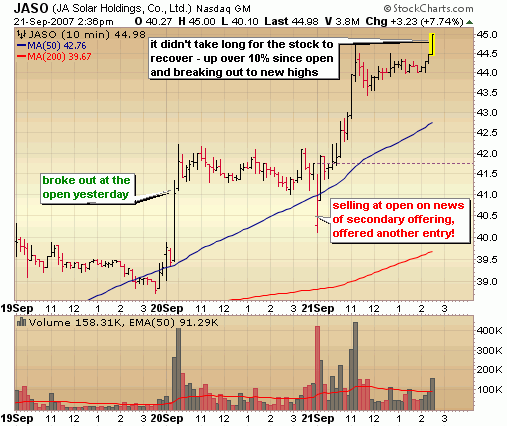
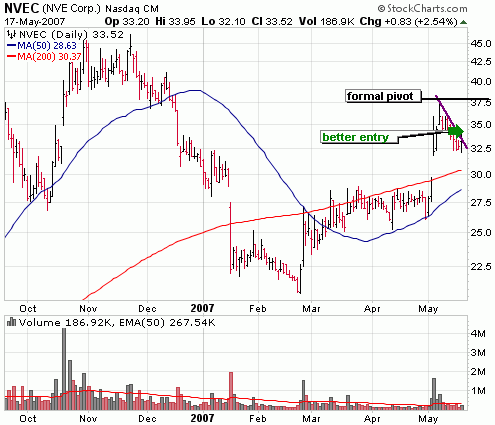
 Today I wanted to highlight a successful day trade in Force Protection (FRPT) (yes, I will highlight some trades that don’t work out too!).. well, actually it was meant to be a 2 day swing trade but I decided to dump the stock given the big run up and the overall market weakness. I’d much rather lock in a big gain and wait patiently for a pull back to the break out point for another low risk entry. Force Protection (FRPT) is a stock that has been in my watchlist for some time and I had a real time alert set on it at 24.50 so I’d be alerted to any breakout move, which it got today:
Today I wanted to highlight a successful day trade in Force Protection (FRPT) (yes, I will highlight some trades that don’t work out too!).. well, actually it was meant to be a 2 day swing trade but I decided to dump the stock given the big run up and the overall market weakness. I’d much rather lock in a big gain and wait patiently for a pull back to the break out point for another low risk entry. Force Protection (FRPT) is a stock that has been in my watchlist for some time and I had a real time alert set on it at 24.50 so I’d be alerted to any breakout move, which it got today: